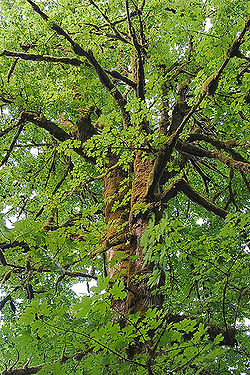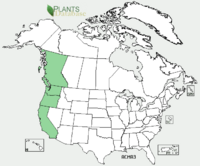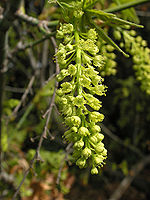Bigleaf maple
| Bigleaf maple |
|---|

|
| Scientific Classification |
|
| Scientific Name |
|
Acer macrophyllum |
| Distribution of Acer macrophyllum |
Bigleaf Maple is a species of maple tree known by the scientific name Acer macrophyllum. It is native to the Pacific Northwest, but is now spread over much of the west coast and Cascade Mountain range. It is a very common find in many rural areas, and often grows among conifers. The tree has many uses to mankind other than its ornamental appeal or value as a shade tree.
Anatomy
The Bigleaf Maple is a fairly large deciduous tree (drops its leaves in winter), growing anywhere between 30 and 100 feet tall. It normally has a diameter of about 2 to 4 feet. When planted in the open the branches form a rounded crown shape, but when grown among other trees it grows taller and straighter. This plant usually sprouts from the base, and forms big basal burls. This plant is very similar to the Sugar maple, Vine maple, Rocky Mountain maple, and the California sycamore, so it is commonly mistaken in parts of the United States.
This tree is made up of many different parts, including:
The leaf: The leaf is a simple, deciduous leaf, and it is between 6 to 12 inches in diameter, but sometimes much larger. It is also palmately lobed, which means the leaf has five "arms." The leaf is dark green on the top, and light green on the bottom. When crushed or cut, the petiole discharges a white sap.
The flower: The flowers are monoecious. The flowers are a small, and are often yellow. They bloom in long racemes.
The fruit: The fruit are double samaras. The wings on the samaras are 1.5 to 2 inches long, and occur at acute angles. The head of the seed appears to be hairy. When the seed is mature, it turns a tan color.
The twig: The twig is smooth, round, and commonly a pale green in color. In the fall, it turns a bright green red, and finally grayish brown. There are two buds on opposite sides of a main bud, which are bigger than the other two, and these buds have 3 or 4 scales.
The bark: When the tree is young, the bark is a brownish color with a smooth layer. As the tree matures, it becomes a darker brown, and furrows and ridges begin to appear on the outer layer of the bark.[1]
The roots: The roots of the tree are often shallow but widespread; this type of root system make it easier for the plant to grow shallow or saturated soils.[2]
Reproduction
The Bigleaf maple's main form of reproduction is sexually, but it can also reproduce vegetatively. The flowers on the bigleaf maple start to show up when the tree is about 10 years old, but trees growing in an open area start to produce flowers earlier and also produce more flowers. These flowers are pollinated by insects, and small animals may also help disperse the seeds. The seed can only germinate for a couple months. If they do not, they will start to decay near the end of the winter months. Even indoors, the seed will not last for more than a few months at low to room temperature. Another factor that reduces germination rates is the consumption of the seeds by rodents. One year old seedlings in Oregon were about 2.3-3 inches in height. This plant grows more slowly when it is grown in the shade of another tree, especially Douglas-firs. This tree can also regrow from the root if it is cut down or killed. [3]
Ecology
The Bigleaf maple can be found in many places along the Pacific coast, but mostly anywhere between just south of the Alaska panhandle in British Columbia and Southern California. It is not found very often east of the Sierra Nevada-Cascade crest. The places that this plant stops growing seem to be characterized by colder weather in the north, and in the south by lack of moisture and humidity. In southern California, this plant only grows in canyons or near streams. This plant is commonly found in groups with the following plants: Sitka Spruce, Western Hemlock, Douglas-Fir, Grand Fir, Redwoods, Oregon white oak, and other evergreens common to the same area.
This maple is used for many things, making it the most important maple on the Pacific coast. It is used in making furniture, making musical instruments, interior paneling, and many other places where hardwoods are preferred. In California, however, this tree is not considered among the most economically important trees; it is usually intentionally knocked down, but not harvested, in favor of Douglas-firs and redwoods. The Bigleaf Maple is eaten sometimes by deer in the summer months, but otherwise not eaten by animals after the leaves have fallen. This plant is occasionally sampled by humans, in the form of either ground up powder or syrup extracted from the sap.[4]
Adaptation to Fire
Bigleaf maples easily regrows after fires. It commonly sprouts back from the root crown after being destroyed by fire. In the upper Cascade Mountains, this tree is one of the first to come back after the destruction of an ecosystem. However, this does not change the overall spread of the plant. Seedlings from this tree are not often reported in burned areas, but it it more likely that they are carried by birds and other mammals to their new sites.[5] Because this plant often grows near streams, it was untouched in places by the Tillamook Burn of 1933 to 1951.[6][7]
Gallery
 Browse |
References
- USDA, NRCS. 2010. The PLANTS Database (http://plants.usda.gov, 10 May 2010). National Plant Data Center, Baton Rouge, LA 70874-4490 USA.
- Index of Species Information, Acer Macrophyllum Uchytil, Ronald J. U.S. Department of Agriculture, Forest Service, Rocky Mountain Research Station, Fire Sciences Laboratory. 1989
- Acer macrophyllum Fact sheet Virginia Tech. 2010
- Maple-Trees.com Acer macrophyllum Don Minore and John C. Zasada. Maple-Trees.com.
- Wikipedia - Tillamook Burn Wikipedia. Last edit on May 10, 2010







